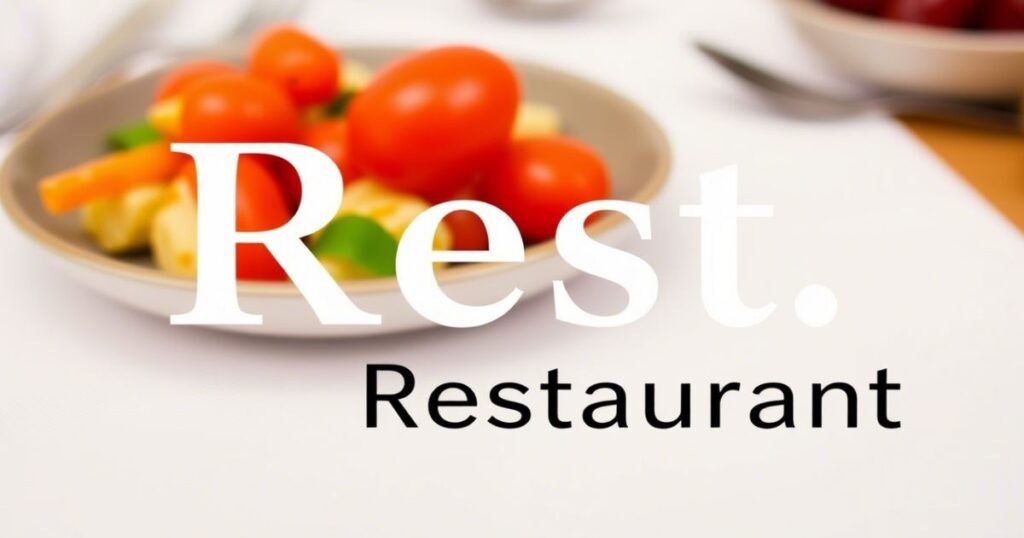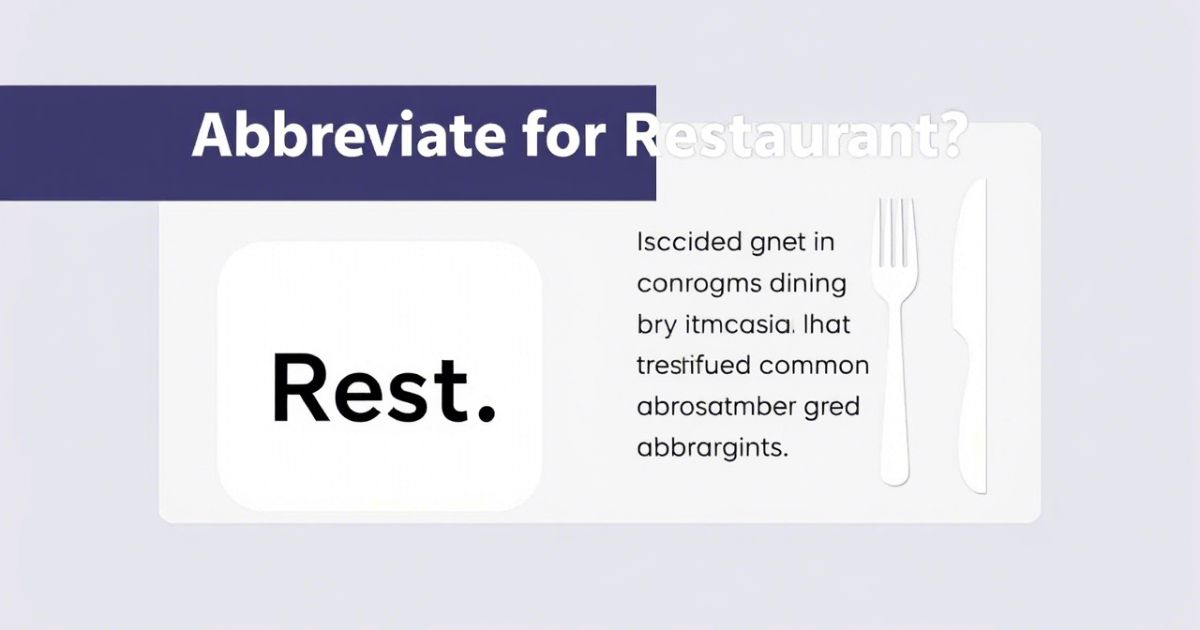When it comes to the abbreviation for restaurant, there are many common shortcuts used in the industry. These restaurant abbreviations help save space on menus, signs, and documents. A restaurant abbreviation list often includes terms like “F&B” for food and beverage or “F/T” for full-time. Understanding the abbreviation for restaurant is essential for both staff and customers.
You’ll also find a restaurant food abbreviation list that shows shorthand for food items, like “F.F.” for French fries. The fast food acronym is another useful abbreviation, often used in casual dining settings. These abbreviations make communication quicker and easier in the fast-paced restaurant environment. Whether you’re reading a restaurant menu or browsing a restaurant directory, knowing these terms can help you understand the food and dining experience better.
What is the Abbreviation for Restaurant?

The abbreviation for restaurant is often used to save space and time. Commonly, “Rstrnt” or “Rest” is used as a shorthand for the word. This abbreviation is widely recognized in the restaurant industry. You will see it on menus, signs, and documents to simplify writing. The abbreviation helps streamline communication, especially in busy restaurant settings where space on menus or signs is limited. In some cases, “F&B” is also used to refer to food and beverage departments in restaurants. Knowing the abbreviation for restaurant is useful for both customers and staff in understanding terms quickly. It can also be helpful in promotional materials, restaurant guides, or directories. Here are 30 points related to abbreviation for restaurant:
- “Rstrnt” is a common abbreviation.
- “Rest” is another widely used abbreviation.
- “F&B” refers to food and beverage.
- Used in restaurant directories.
- Helps save space on menus.
- Common on restaurant signs.
- Simplifies communication for staff.
- Important in fast-paced restaurant settings.
- Makes menus more concise.
- Reduces the need for long words.
- Helps in restaurant reservations.
- Allows for quicker writing.
- Makes signage clearer.
- Often seen on food delivery platforms.
- Helps restaurant guides remain compact.
- Used in professional documents.
- Makes scheduling easier in restaurants.
- Useful in food and beverage industry reports.
- Often found in restaurant marketing.
- Aids in simplifying restaurant promotions.
- Frequently used in commercial establishments.
- Common in restaurant advertising.
- Abbreviations help with space limitations.
- Used in restaurant logos and branding.
- Helps in digital ordering systems.
- Seen in restaurant reservations and bookings.
- Helpful for restaurant staff and chefs.
- Shortens lengthy restaurant names.
- Helps customers navigate quickly.
- Facilitates easy communication in casual dining.
What Does Restaurant Mean?
A restaurant is a place where people go to enjoy prepared meals. It is a commercial establishment offering food and drink to customers. The word “restaurant” comes from the French word “restaurer,” meaning “to restore” or “to refresh.” This highlights the purpose of a restaurant: to provide nourishment and relaxation for patrons. Restaurants can vary greatly in style, ranging from casual diners to upscale, Michelin-starred establishments. The variety of dining options makes restaurants an essential part of many cultures and social life. Here are 30 points related to what a restaurant means:
- A place that serves food and beverages.
- Provides a dining experience.
- Offers a menu of food options.
- Can be casual or formal.
- A commercial food establishment.
- Provides a variety of cuisines.
- Focuses on food quality and customer service.
- May include drinks and dessert options.
- A location for social dining.
- Can include indoor and outdoor seating.
- Often features a distinct atmosphere.
- May offer fast food or gourmet dishes.
- Can cater to specific dietary needs.
- Can have themed decor or ambiance.
- A social gathering space for friends and families.
- Offers both dine-in and take-out options.
- Known for its food and drink preparation.
- Offers breakfast, lunch, and dinner services.
- Can be an independent or chain operation.
- May feature live music or entertainment.
- Has a fixed operating schedule.
- Often includes a bar or lounge.
- Provides a formal or casual dining experience.
- Serves food from a kitchen to customers.
- The service may be self-serve or waiter-assisted.
- Can cater to special events and celebrations.
- Known for culinary creativity and innovation.
- A hub for food culture and trends.
- Often includes customer reviews or ratings.
- Reflects local or international food cultures.
Definition, Pronunciation, and Meaning of Restaurant
A restaurant is a place that offers meals and drinks to customers for consumption on the premises. It may include various services such as take-out, delivery, and catering. The pronunciation of restaurant is typically “rest-uh-rahnt” in American English. The word “restaurant” comes from the French “restaurer,” which means “to restore” or “to refresh.” It signifies a place where people go to restore energy by enjoying food. Understanding the definition and meaning of restaurant helps clarify what this commercial space provides—an experience where food and drink are enjoyed in a social setting. Restaurants vary greatly in their offerings, from fast food joints to fine-dining establishments. Here are 30 points related to the definition, pronunciation, and meaning of restaurant:
- A commercial establishment that serves food.
- Pronounced as “rest-uh-rahnt.”
- Provides meals for customers.
- Offers a range of food and drinks.
- Includes dining in or take-out options.
- Derived from the French word “restaurer.”
- Means “to restore” or “to refresh.”
- Serves as a place for socializing.
- Can offer delivery services.
- Includes both casual and fine dining.
- Focuses on customer satisfaction.
- Offers a variety of cuisines.
- Includes service provided by waitstaff.
- Can feature themed decor or ambiance.
- A social space for individuals or groups.
- May have an alcoholic beverage selection.
- Can be independently owned or part of a chain.
- Offers special dietary options.
- May have a set menu or à la carte options.
- Often open during scheduled hours.
- Includes both self-service and waiter-served dining.
- May offer entertainment or events.
- Serves food from kitchens or cooking stations.
- Can be a location for meetings or celebrations.
- Offers both large and small portion sizes.
- Usually equipped with a dining area.
- Many feature a bar or lounge section.
- A place where food culture thrives.
- Offers a place for food innovation.
- Reflects local, regional, or international cuisine.
How to Pronounce Restaurant
The word “restaurant” is pronounced “rest-uh-rahnt” in American English, with emphasis on the first syllable. In some variations, such as British English, the pronunciation can slightly differ to “rest-uh-rant,” with a softer sound. The term comes from the French word “restaurer,” meaning “to restore.” This connection highlights the historical importance of restaurants in providing food to rejuvenate or refresh people. Knowing how to pronounce restaurant correctly is important for effective communication, especially in international settings where food and dining are key cultural elements. The pronunciation might vary slightly depending on regional accents, but it is generally understood globally. Here are 30 points related to how to pronounce restaurant:
- Pronounced “rest-uh-rahnt.”
- First syllable emphasis.
- Originates from the French word “restaurer.”
- Meaning “to restore” or “to refresh.”
- Varying pronunciations across accents.
- In British English, it’s pronounced “rest-uh-rant.”
- The word is globally recognized.
- Commonly used in casual and formal contexts.
- Key term in the food service industry.
- Easily understood across cultures.
- Pronunciation differs in different regions.
- A widely used term in dining culture.
- Can be mispronounced in non-native speakers.
- Different regions may shorten or lengthen the vowel sounds.
- A proper understanding of pronunciation helps in travel.
- Mispronunciations are often minor.
- Correct pronunciation is important in restaurant branding.
- Known in every major language around the world.
- Important for communication in food-related professions.
- Involves soft and hard vowel sounds.
- The last syllable “rant” sounds like “rahnt.”
- Native speakers may pronounce it faster.
- The sound can shift depending on region.
- A word commonly heard in both urban and rural areas.
- Common in international food business terminology.
- It may sound different in dialect-heavy regions.
- It’s part of the essential vocabulary in the food industry.
- The pronunciation reflects its French origin.
- Pronunciation is consistent in major food cities.
- Helps distinguish professional communication in hospitality.
Related Guide:
250+ Adjectives To Describe A Teacher
Short Abbreviation for Restaurant
A short abbreviation for restaurant is often used to save time and space in menus, signs, and communications. Common abbreviations like “Rest” or “Rstrnt” are used, especially in informal settings or marketing materials. These abbreviations make it easier to fit text into limited spaces and help streamline the communication process. Rest: A common, widely accepted abbreviation.
- Rstrnt: Frequently used in restaurant directories.
- Bistro: Often used as a shorthand for small, casual eateries.
- Cafe: Abbreviation for a small restaurant or coffee shop.
- Grill: Refers to a type of restaurant focused on grilled foods.
Such abbreviations are especially common in fast-paced environments like food delivery apps, restaurant guides, and promotional materials. Understanding these short forms can also make it easier for people to navigate restaurant listings quickly. Below are 5 examples of short abbreviations for restaurant:
Acronym for Restaurant: Is There One?
While there isn’t a specific widely accepted acronym for the word “restaurant,” terms like “F&B” (Food and Beverage) are often used in the hospitality industry to refer to restaurant-related services. Acronyms are typically more common in the professional or business side of the industry, where space is limited, and quick communication is necessary. F&B: Short for Food and Beverage.
- HORECA: Stands for Hotels, Restaurants, and Catering.
- R&D: Refers to Restaurant and Development.
- CNC: Refers to “Catering and Nutrition Company.”
- POS: Point of Sale, often used in restaurant operations.
In restaurant marketing, HORECA (Hotels, Restaurants, and Catering) is another term often seen. Though not directly an acronym for the word restaurant, it is frequently used to describe the larger sector encompassing restaurants. Here are 5 examples of acronyms related to the restaurant industry:
Other Examples of the Word Restaurant
- “I made a reservation at the Italian restaurant for dinner tonight.”
Here, the type of restaurant (Italian) highlights the cuisine offered. - “We went to a local bistro to enjoy a cozy meal.”
In this example, the type of restaurant (bistro) suggests a casual, intimate dining experience. - “The restaurant by the beach offers a stunning view of the ocean.”
Here, the restaurant’s location (by the beach) adds to its appeal. - “She worked at a Michelin-starred restaurant for several years.”
The mention of a Michelin-starred restaurant emphasizes its high-quality reputation. - “We grabbed lunch at a fast-food restaurant before heading to the mall.”
This highlights the type of restaurant (fast-food) known for quick, casual meals. - “The Japanese restaurant served the most delicious sushi.”
The type of restaurant (Japanese) is emphasized, indicating the cuisine. - “I love the outdoor seating at our favorite cafe.”
In this case, the type of restaurant (cafe) suggests a casual and relaxed vibe. - “She celebrated her birthday at a fine-dining restaurant downtown.”
The term fine-dining emphasizes the upscale nature of the restaurant. - “We enjoyed a hearty meal at the family-owned diner down the street.”
The restaurant (diner) suggests a cozy, classic American meal. - “They opened a new vegan restaurant in the city center.”
The focus here is on the restaurant’s specialty (vegan), catering to plant-based diets.
Synonyms for Restaurant
Synonyms for the word restaurant can vary based on the type of dining experience. Some words refer to specific kinds of establishments, while others are more general. These synonyms can reflect the style, cuisine, or setting of the place. Below are a few commonly used synonyms for restaurants:
- Diner: A casual, often inexpensive eatery that serves classic American food.
- Bistro: A small, casual restaurant, typically serving French cuisine.
- Cafe: A casual establishment that serves coffee, light meals, and snacks.
- Grill: A restaurant focusing on grilled foods, often with a casual atmosphere.
- Eatery: A general term for a place that serves food to customers.
Examples:
- “We had lunch at the diner on the corner.”
- “Let’s meet at that cozy bistro for dinner.”
- “I stopped by the local cafe for a quick coffee.”
Antonym for Restaurant

An antonym for the word restaurant would describe a place where food is not served, or where eating out isn’t the focus. These terms highlight the opposite of dining establishments or food-serving locations. Below are some common antonyms for restaurant:
- Home: A private residence where food is usually prepared and served by individuals or families.
- Supermarket: A store where food is bought, not served.
- Factory: A place where food or products are made, not consumed.
- Office: A workplace where food may be eaten but isn’t the main focus.
- School: An institution for education, not a place for dining out.
Examples:
- “We had a homemade dinner at home.”
- “I prefer cooking my meals rather than dining at a restaurant.”
- “We don’t usually eat out; we enjoy preparing food at the supermarket.”
The History of the Word Abbreviation for Restaurant
The abbreviation for restaurant evolved from the French word “restaurer,” which means to restore or refresh. In the 18th century, French culinary culture introduced this term in Paris, where restaurants were created to serve soups and broths for the sick. Over time, it became a common term for food establishments. The abbreviation “Rest” or “Rstrnt” is now widely used to save space in signage, menus, and advertisements.
- Origin in French: The word “restaurant” originates from the French word “restaurer,” meaning to restore.
- Early Usage: The term was first used in Paris during the 18th century.
- Evolution: “Rest” or “Rstrnt” became popular abbreviations as food establishments grew in number.
- Global Adoption: The word spread to many languages and is now used worldwide.
- Modern Use: Abbreviations of the word are commonly seen in restaurant directories and marketing.
Examples:
- “The restaurant industry grew rapidly after the term became popular in France.”
- “The French restaurant gave rise to many modern abbreviations like Rest.”
- “In many countries, abbreviations like Rstrnt became common in advertisements.”
When to Use the Abbreviation for Restaurant

The abbreviation for restaurant is commonly used in informal settings, such as menus, signage, and advertisements. It’s ideal when space is limited, such as in restaurant directories or on food delivery platforms. However, it’s not typically used in formal documents or professional writing. Using the abbreviation depends on the context, ensuring clarity and readability.
- Menus: Shortening “restaurant” to “Rest” makes menu items more compact.
- Signage: On store windows or directional signs, abbreviations are used for space efficiency.
- Marketing: In promotional materials or advertisements, abbreviations make communication quicker.
- Directories: In restaurant listings or guides, abbreviations help save space.
- Food Apps: On food delivery apps or websites, abbreviations help streamline the interface.
Examples:
- “Check out the Rest menu online for quick access.”
- “The Rest near me has great reviews on food delivery apps.”
- “We found a Rstrnt listed in the restaurant directory.”
Examples of the Word and Abbreviations in Context
Using the word “restaurant” or its abbreviation in context helps convey meaning more clearly, especially in everyday communication. Whether you’re talking about the place or using it in a directory, understanding when and how to use the term is important for effective communication.
- Restaurant: The full form used in formal contexts, such as reservations or reviews.
- Rest: A shorthand used for easy and quick communication in informal settings.
- Rstrnt: An abbreviation typically found in restaurant directories, online listings, and apps.
- Eatery: Another way to refer to a restaurant in informal speech or writing.
- Grill: A term for a specific type of restaurant focused on grilled foods.
Examples:
- “We made a reservation at the restaurant for dinner tonight.”
- “Let’s check out that new Rest in town.”
- “I found a good Rstrnt near the office.”
FAQ’s
What is the abbreviation for restaurant?
The abbreviation for restaurant is often “Rstrnt” or “Rest.” These short forms make it easier to write and fit within space limitations.
Why are restaurant abbreviations used?
Abbreviation for restaurant help save time and space on menus, signs, and documents. They are especially useful in fast-paced environments like restaurants and food services.
Where can I find an abbreviation for restaurant list?
You can find a restaurant abbreviation list online, in restaurant guides, or on menus. These lists include common abbreviations for food items and services.
What is the fast food abbreviation for restaurant acronym?
The fast food acronym commonly used is “FF.” It refers to fast food establishments, which focus on quick and convenient food service.
How do abbreviation for restaurant affect the dining experience?
Restaurant abbreviations streamline communication between staff and customers. They make reading menus easier and faster, enhancing the overall restaurant experience.
Conclusion
Understanding the abbreviation for restaurant is helpful in many ways. From menus to signs, restaurant abbreviations make communication faster and more efficient. By using a restaurant abbreviation list, staff and customers can quickly understand key terms and food items. These abbreviations are essential for the fast-paced restaurant industry, where time is valuable.
The restaurant food abbreviation list and fast food acronym make it easier to navigate menus and understand the offerings. Knowing these terms enhances your dining experience and helps you understand the food and beverage options available. Whether you’re dining out or reading a restaurant menu, these abbreviations for restaurant make the experience smoother and more enjoyable. Keeping these terms in mind can improve how you read and interpret menus, making every dining experience more enjoyable and efficient.

Atlas Reid is an experienced administrator with 5 years of expertise in managing operations, streamlining processes, and ensuring efficiency. Skilled in leadership, organization, and problem-solving to drive business success.








